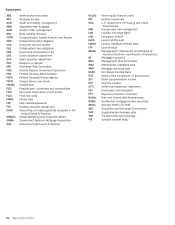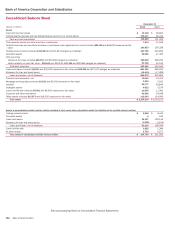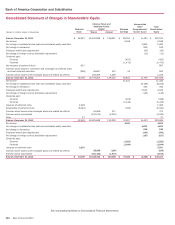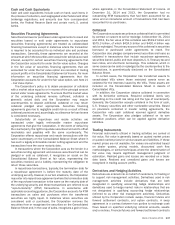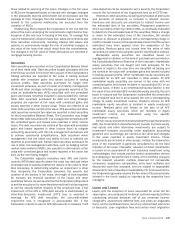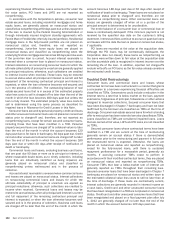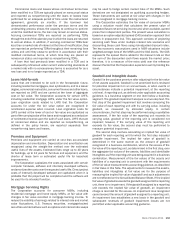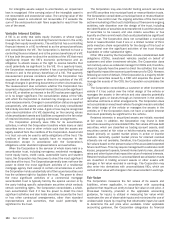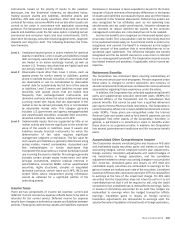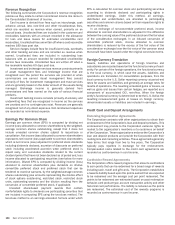Bank of America 2014 Annual Report Download - page 148
Download and view the complete annual report
Please find page 148 of the 2014 Bank of America annual report below. You can navigate through the pages in the report by either clicking on the pages listed below, or by using the keyword search tool below to find specific information within the annual report.146 Bank of America 2014
Bank of America Corporation and Subsidiaries
Notes to Consolidated Financial Statements
NOTE 1 Summary of Significant Accounting
Principles
Bank of America Corporation (together with its consolidated
subsidiaries, the Corporation), a bank holding company (BHC) and
a financial holding company, provides a diverse range of financial
services and products throughout the U.S. and in certain
international markets. The term “the Corporation” as used herein
may refer to Bank of America Corporation individually, Bank of
America Corporation and its subsidiaries, or certain of Bank of
America Corporation’s subsidiaries or affiliates.
The Corporation conducts its activities through banking and
nonbank subsidiaries. Prior to October 1, 2014, the Corporation
operated its banking activities primarily under two charters: Bank
of America, National Association (Bank of America, N.A. or BANA)
and, to a lesser extent, FIA Card Services, National Association
(FIA Card Services, N.A. or FIA). On October 1, 2014, FIA was
merged into BANA.
Principles of Consolidation and Basis of Presentation
The Consolidated Financial Statements include the accounts of
the Corporation and its majority-owned subsidiaries, and those
variable interest entities (VIEs) where the Corporation is the
primary beneficiary. Intercompany accounts and transactions have
been eliminated. Results of operations of acquired companies are
included from the dates of acquisition and for VIEs, from the dates
that the Corporation became the primary beneficiary. Assets held
in an agency or fiduciary capacity are not included in the
Consolidated Financial Statements. The Corporation accounts for
investments in companies for which it owns a voting interest and
for which it has the ability to exercise significant influence over
operating and financing decisions using the equity method of
accounting. These investments are included in other assets. Equity
method investments are subject to impairment testing and the
Corporation’s proportionate share of income or loss is included in
equity investment income.
The preparation of the Consolidated Financial Statements in
conformity with accounting principles generally accepted in the
United States of America requires management to make estimates
and assumptions that affect reported amounts and disclosures.
Realized results could differ from those estimates and
assumptions.
The Corporation evaluates subsequent events through the date
of filing with the Securities and Exchange Commission (SEC).
Certain prior-period amounts have been reclassified to conform to
current period presentation.
New Accounting Pronouncements
In August 2014, the Financial Accounting Standards Board (FASB)
issued new accounting guidance on classification and
measurement of foreclosed mortgage loans that are government
guaranteed. This new guidance states that such foreclosed
properties should be classified as other assets and measured
based on the amount of the loan balance expected to be recovered
from the guarantor. The new guidance is effective beginning on
January 1, 2015 using either a prospective or modified
retrospective transition method. This new guidance will not have
a material impact on the Corporation’s consolidated financial
position or results of operations.
In August 2014, the FASB issued new accounting guidance that
provides a measurement alternative for entities that consolidate
a collateralized financing entity (CFE). The new guidance allows an
entity to measure both the financial assets and financial liabilities
of a CFE using the fair value of either the financial assets or
financial liabilities, whichever is more observable. This alternative
is available for CFEs where the financial assets and financial
liabilities are carried at fair value and changes in fair value are
reported in earnings. The new guidance is effective beginning on
January 1, 2016. This new guidance will not have a material impact
on the Corporation’s consolidated financial position or results of
operations.
In June 2014, the FASB issued new guidance on accounting
and disclosure of repurchase-to-maturity (RTM) transactions and
repurchase financings (repos). Under this new accounting
guidance, RTMs will be accounted for as secured borrowings rather
than sales of an asset, and transfers of financial assets with a
contemporaneous repo will no longer be evaluated to determine
whether they should be accounted for on a combined basis as
forward contracts. The new guidance also prescribes additional
disclosures particularly on the nature of collateral pledged in repos
accounted for as secured borrowings. The new guidance is
effective beginning on January 1, 2015. This new guidance will not
have a material impact on the Corporation’s consolidated financial
position or results of operations.
In May 2014, the FASB issued new accounting guidance to
clarify the principles for recognizing revenue from contracts with
customers. The new accounting guidance, which does not apply
to financial instruments, is effective on a retrospective basis
beginning on January 1, 2017. The Corporation does not expect
the new guidance to have a material impact on its consolidated
financial position or results of operations.
In January 2014, the FASB issued new guidance on accounting
for qualified affordable housing projects which permits entities to
make an accounting policy election to apply the proportional
amortization method when specific conditions are met. The new
accounting guidance is effective on a retrospective basis beginning
on January 1, 2015 with early adoption permitted. The Corporation
is currently assessing whether it will adopt the proportional
amortization method. If adopted, the Corporation does not expect
it to have a material impact on its consolidated financial position
or results of operations.
In December 2012, the FASB issued a proposed standard on
accounting for credit losses. It would replace multiple existing
impairment models, including an “incurred loss” model for loans,
with an “expected loss” model. The FASB has not yet established
an effective date but a final standard is expected to be issued in
the second half of 2015. The final standard may materially reduce
retained earnings in the period of adoption.


